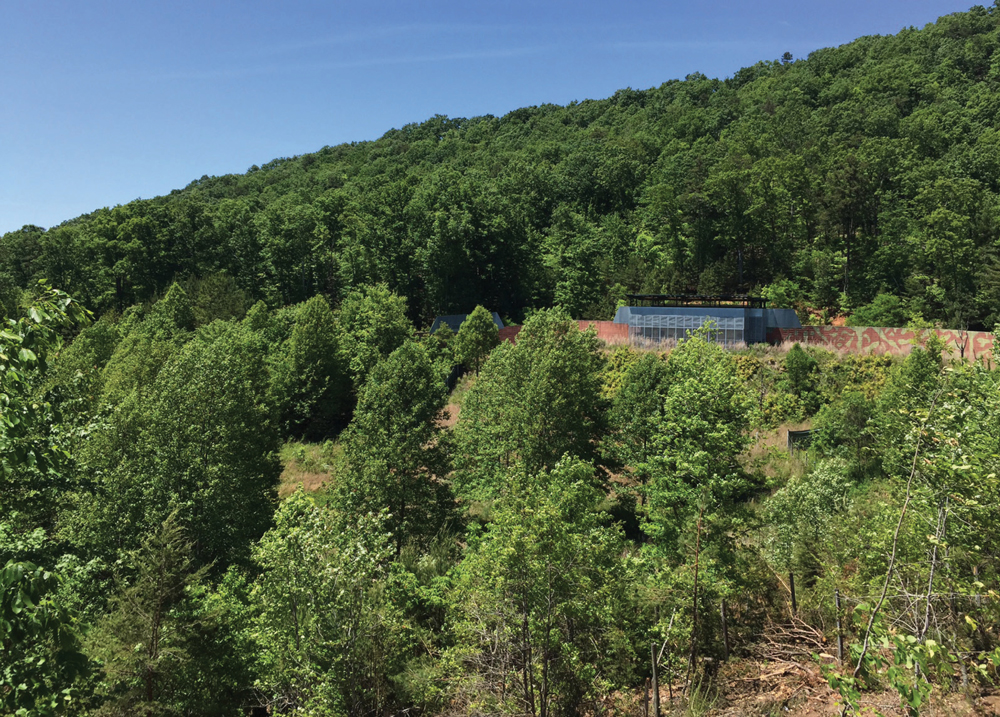
Halfway up a mountain road, the unmarked turnoff looks like it leads to a summer camp. A gravel driveway snakes through the thick North Georgia woods and emerges at an opening flanked by tall pines. But just ahead looms a gate, a 10-foot-high barbed-wire fence, and a warning sign: “Danger—High Voltage.” Suddenly this feels more like a mountainous version of Jurassic Park.
Fortunately, the creatures that will occupy this enclosure are more benign than velociraptors.
Soon, as many as 300 chimpanzees will climb trees, drink smoothies, and play with toy trucks and stuffed bears in their version of retirement on a 236-acre spread about 10 miles from the town of Blue Ridge.
The new sanctuary is partly the result of a major change in policy by the National Institutes of Health. Acknowledging the ethical burdens posed by the close link between chimpanzees and humans—they share 98.8 percent of their DNA—the agency in 2013 phased out the use of the apes in federally funded medical research. Two years later the U.S. Fish and Wildlife Service extended “endangered” status to chimps in captivity, which means even privately funded research must benefit the animals as well as humans.
Since no existing sanctuary could absorb the abrupt retirement of so many chimpanzees, primatologist Sarah Baeckler Davis cofounded Project Chimps to provide a home for apes that had been bred or kept for research.
Several of the chimps had given birth repeatedly only to have their babies taken away, says Baeckler Davis, the nonprofit’s president and CEO, who visited the chimps at a research center. “Having been there and met the chimps and looked into their eyes—there wasn’t any way I could not do this,” she says.

Photograph courtesy of Project Chimps
Project Chimps chose this bucolic corner of Georgia best known for vacation cabins and fly-fishing because the spot was already established as a refuge for great apes. Almost 20 years ago, software mogul C.E. Steuart Dewar and his then-wife Jane came to Blue Ridge after deciding to use their millions to help gorillas. They determined that the area’s pristine mountains and streams provided the perfect setting for gorillas coming from zoos.
The Dewars quickly found that not everyone shared their vision. At the time Blue Ridge was down on its luck, its main street lined with empty storefronts. Local leaders were looking to rebrand the town as a weekend getaway spot for wealthy vacationers from Atlanta. Concerned Citizens Against Gorillas in Fannin County gathered about 1,200 signatures, an impressive feat in a county with a population of less than 18,000. Opponents evoked images of gorillas rampaging King Kong–like through the forests, wreaking havoc, and spreading disease.
But the Dewars didn’t give up.
Arguing that most gorillas have a gentle nature, they convinced the county commission to pass an exotic animal ordinance that allowed them to obtain the necessary permits to open the sanctuary. The couple built the electrified fence to enclose about 60 acres, a 15-foot-tall concrete wall to encompass five gorilla “villas” that open out to a wooded habitat, a state-of-the-art veterinary clinic, and other ancillary buildings.
“This was no mom-and-pop operation,” says Steuart Dewar. “Our facility was generally considered the finest in the world for gorillas.”
But the need for a gorilla sanctuary turned out to be less than they’d thought, and the compound never took in more than a handful of guests (including Willie B. Jr. and his buddy Jasiri during their two-year hiatus from Zoo Atlanta). By the time Baeckler Davis came knocking, the site was unoccupied. Project Chimps bought the property for about $1.6 million, and the Dewar Wildlife Trust donated the facilities.
Beginning this fall, the New Iberia Research Center at the University of Louisiana at Lafayette, the world’s largest chimpanzee research facility, will relocate all 220 of its chimps to Blue Ridge. The animals will arrive in social groups of about 10 at a time, a process that will take a few years to complete.
The reception to Project Chimps has been remarkably warmer than when the Dewars first arrived in 1997. Although it won’t be open to the public, Project Chimps will offer occasional educational tours. More importantly, it will put Fannin County in a national spotlight. Renowned chimpanzee expert Jane Goodall has given the project her thumbs-up, and Animal Planet is considering a show.
Celebrity support helps, too, considering that it costs $20,000 to house a chimp for one year. TV chef Rachael Ray designed and funded a kitchen, and Kat Von D created a limited-edition Project Chimps lipstick, with a percentage of the proceeds benefiting the nonprofit. The long-term cost for the sanctuary, which will likely be needed for about 45 years, is projected to be as much as $100 million, says Baeckler Davis, with support coming from New Iberia and the Humane Society, as well as private donations.
Holly Kaylor Nelson of nearby Mineral Bluff once protested the gorillas but has no problem with the chimpanzees. In the past 20 years, her real estate and cabin rental business has flourished, and she looks back on the gorilla ruckus as a misunderstanding. “It was a huge gossip train that went around in small-town living,” she says.
County attorney Lynn Doss agrees; Project Chimps, she says, is “just one more unique thing about our wonderful part of God’s great creation.”
First group of residents slated for project chimps

Top row (L-R) Samira, born May 17, 2003; Latricia, born July 1, 2003; Gertrude, born January 22, 2004
Middle row (L-R) Emma, born January 30, 2005; Twins Charisse and Buttercup, born February 24, 2005
Bottom row (L-R) Genesis, born April 4, 2005; Gracie, born April 1, 2006; Jennifer, born April 21, 2006
This article originally appeared in our October 2016 issue.














